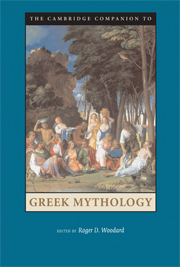Book contents
- Frontmatter
- Introduction: Muthoi in Continuity and Variation
- Part I Sources and Interpretations
- 1 Lyric and Greek Myth
- 2 Homer and Greek Myth
- 3 Hesiod and Greek Myth
- 4 Tragedy and Greek Myth
- 5 Myth in Aristophanes
- 6 Plato Philomythos
- 7 Hellenistic Mythographers
- Part II Response, Integration, Representation
- Part III Reception
- Bibliography
- Index
4 - Tragedy and Greek Myth
from Part I - Sources and Interpretations
Published online by Cambridge University Press: 28 March 2009
- Frontmatter
- Introduction: Muthoi in Continuity and Variation
- Part I Sources and Interpretations
- 1 Lyric and Greek Myth
- 2 Homer and Greek Myth
- 3 Hesiod and Greek Myth
- 4 Tragedy and Greek Myth
- 5 Myth in Aristophanes
- 6 Plato Philomythos
- 7 Hellenistic Mythographers
- Part II Response, Integration, Representation
- Part III Reception
- Bibliography
- Index
Summary
The theatre of Dionysus in fifth-century-BC Athens provided a unique context for myth-telling. At the annual festival of the City Dionysia, myths were reembodied in performances by members of the citizen group. In these reembodiments, as heroes and divinities walked the stage, myths were not just narrated as past events: they were actualised as present happenings. Then and there, but also now and here; remote enough to allow room for pity, but close enough to inspire awe.
In the present attempt to characterise tragic myths, I begin with a discussion (Section 1) of an apparently simple question: What happens in Greek tragedies? In order to suggest an answer, I contrast tragedy with the nontragic mythological tradition, examining in particular the kinds of actions and sufferings ascribed to heroes and heroines. In Section 2 I ask another seemingly straightforward question: Where are Greek tragedies imagined as taking place? My answer involves politics and psychology as well as topography and geography. Finally, in Section 3, I discuss ways in which tragedy represents the gods. Throughout the chapter, my aim is to ask how far it is possible to isolate features which are distinctively tragic.
- Type
- Chapter
- Information
- The Cambridge Companion to Greek Mythology , pp. 166 - 189Publisher: Cambridge University PressPrint publication year: 2007
- 1
- Cited by



